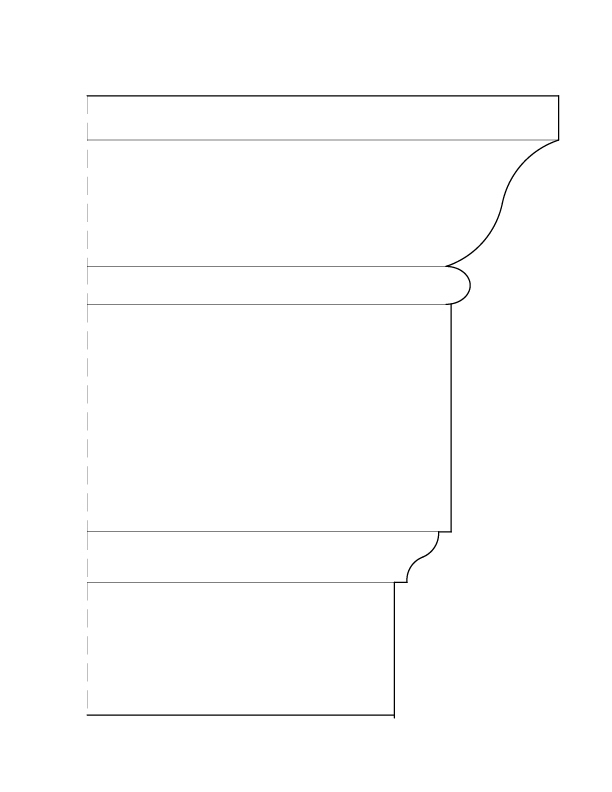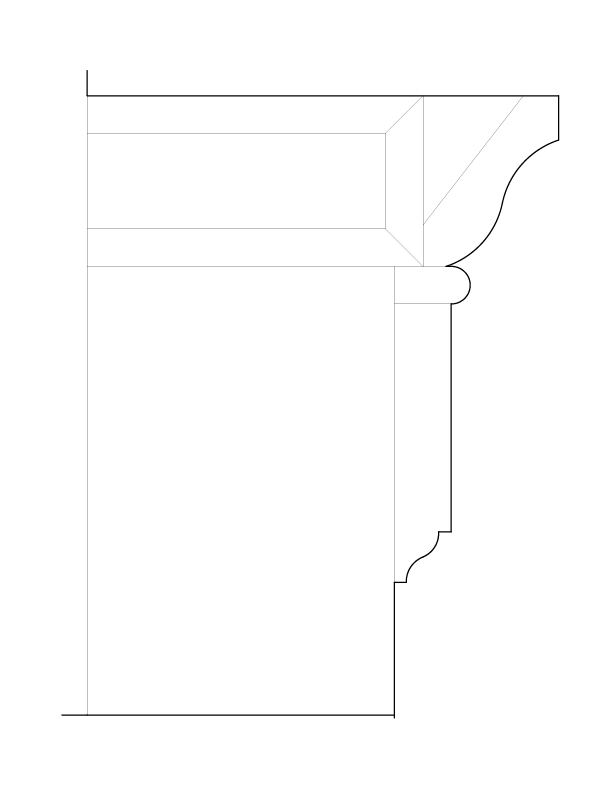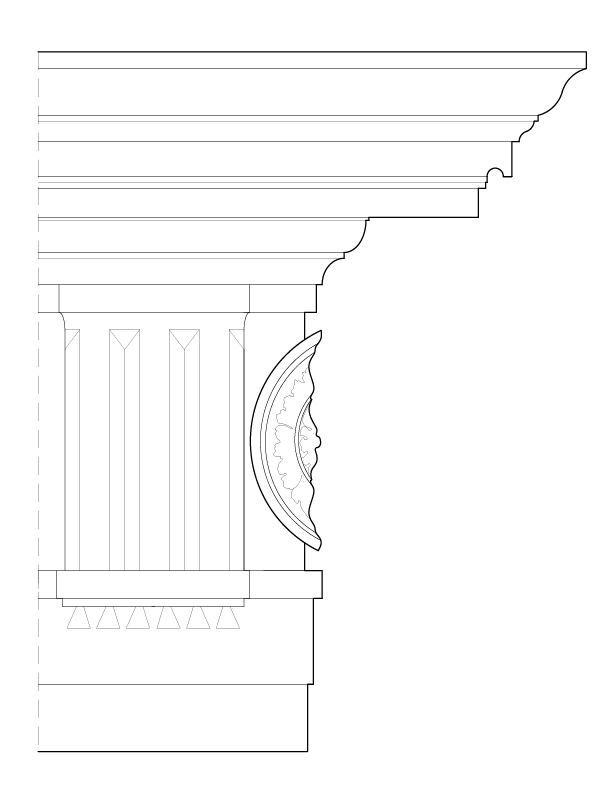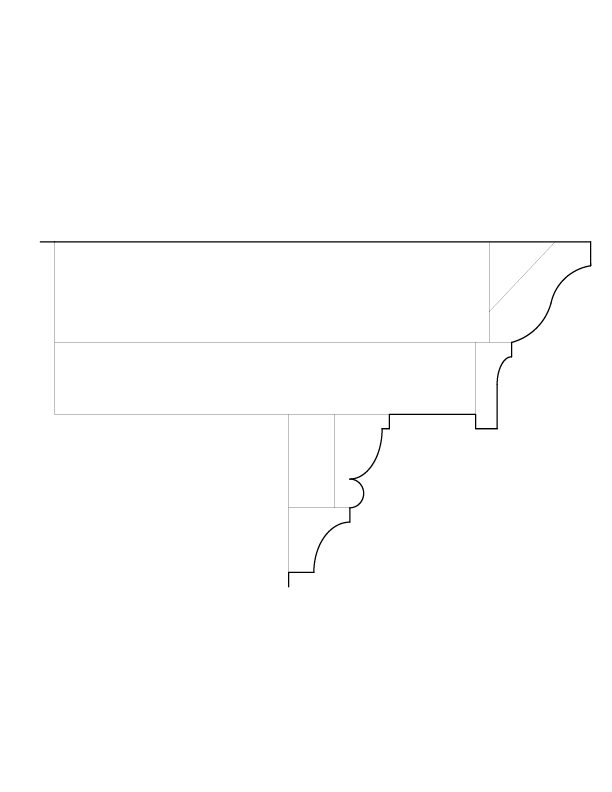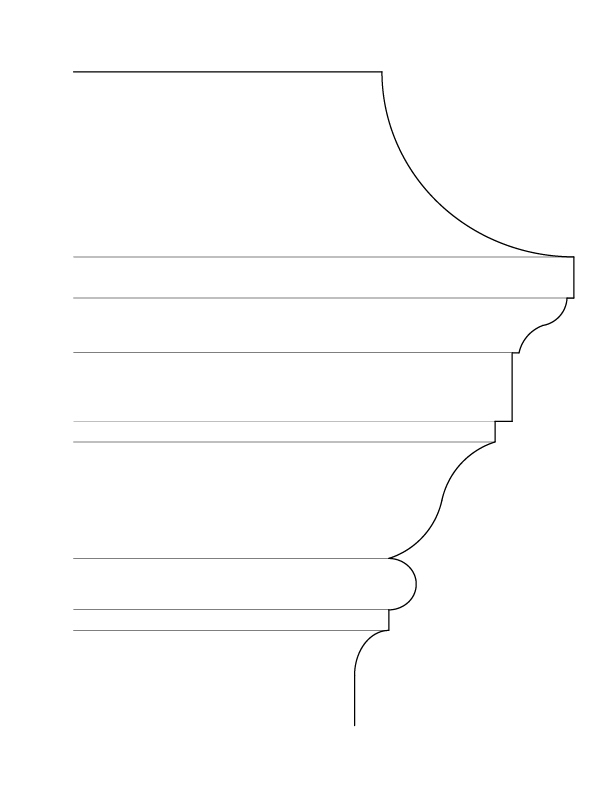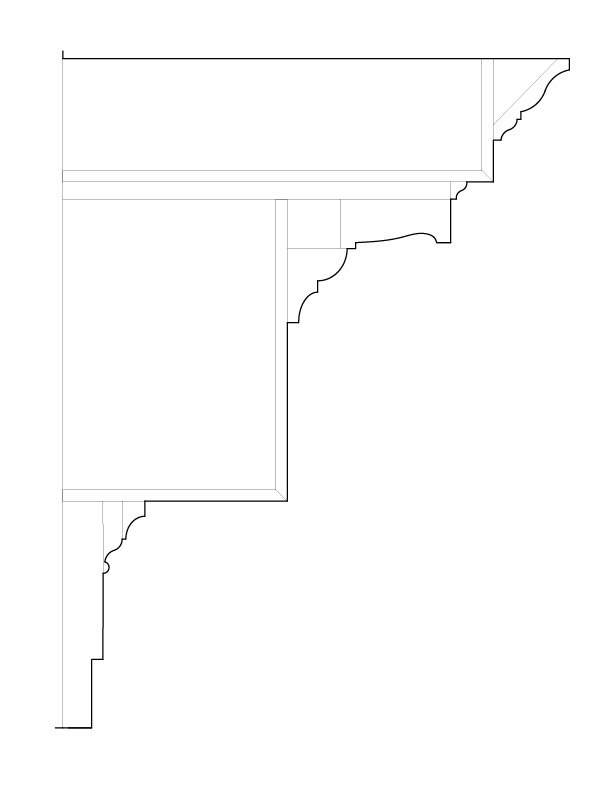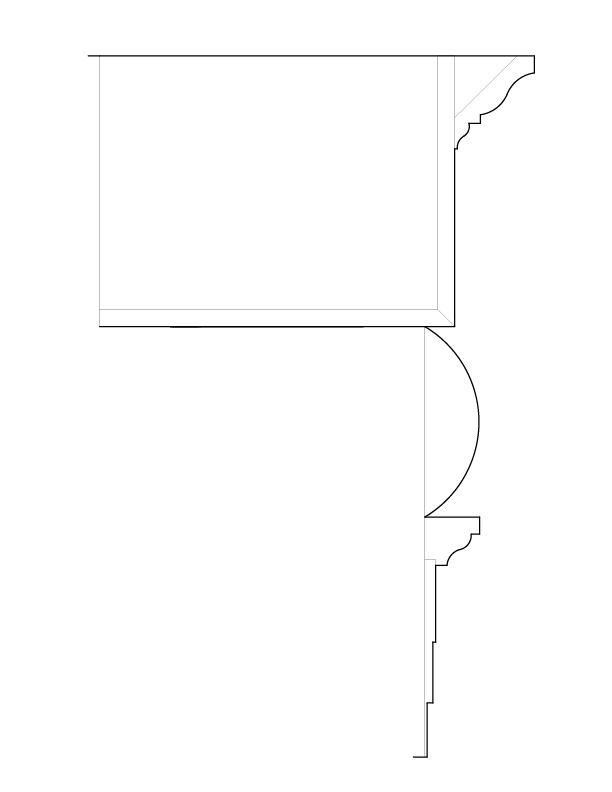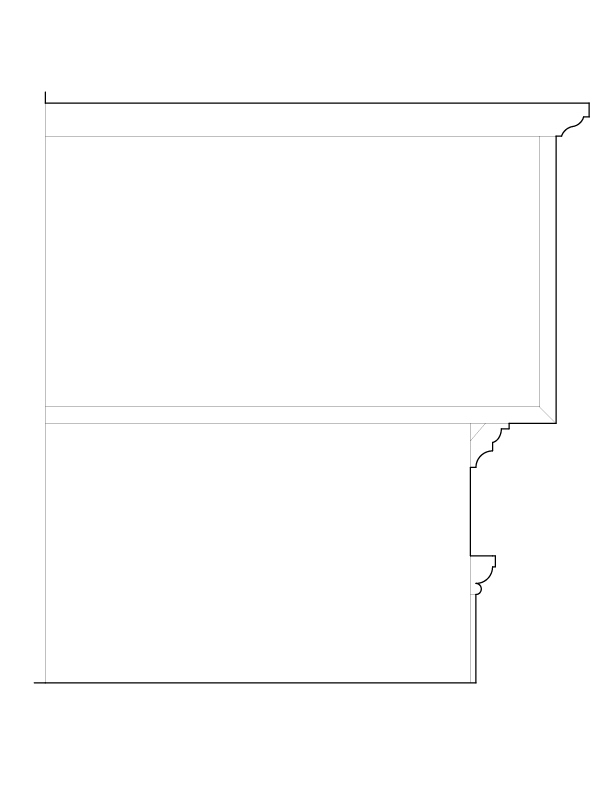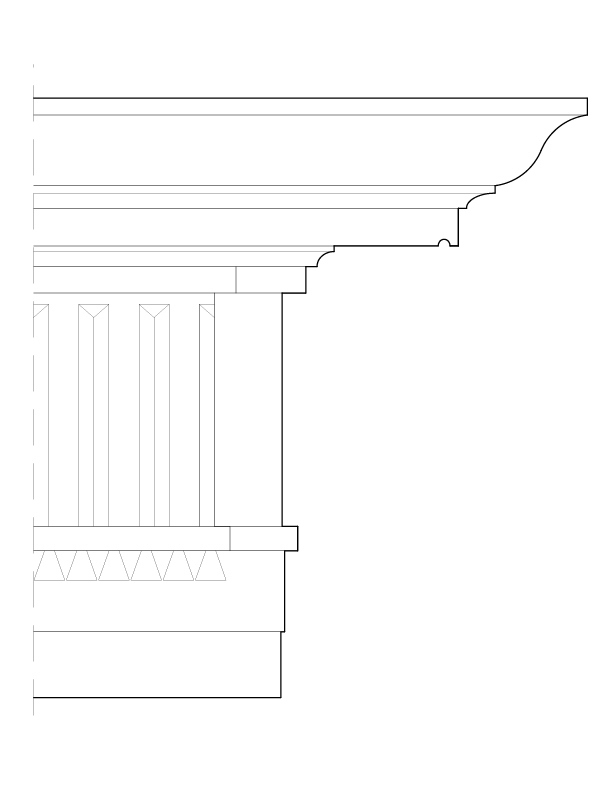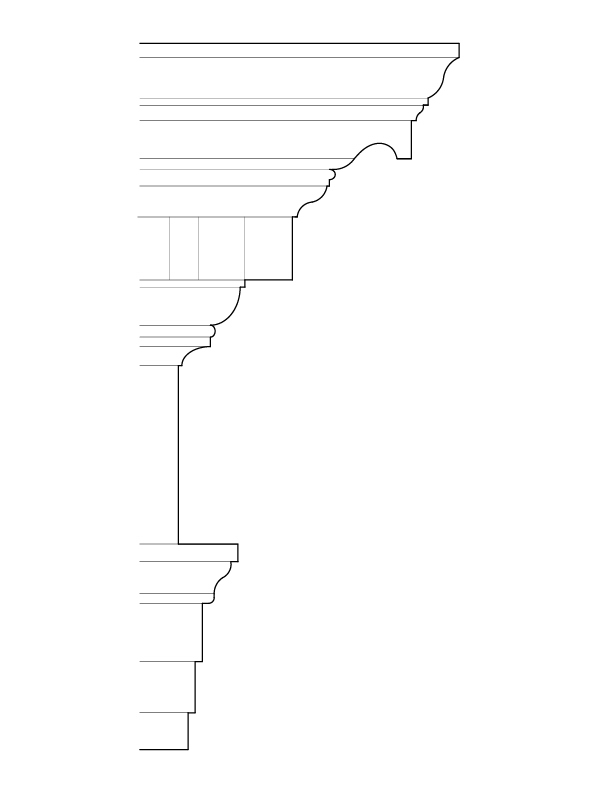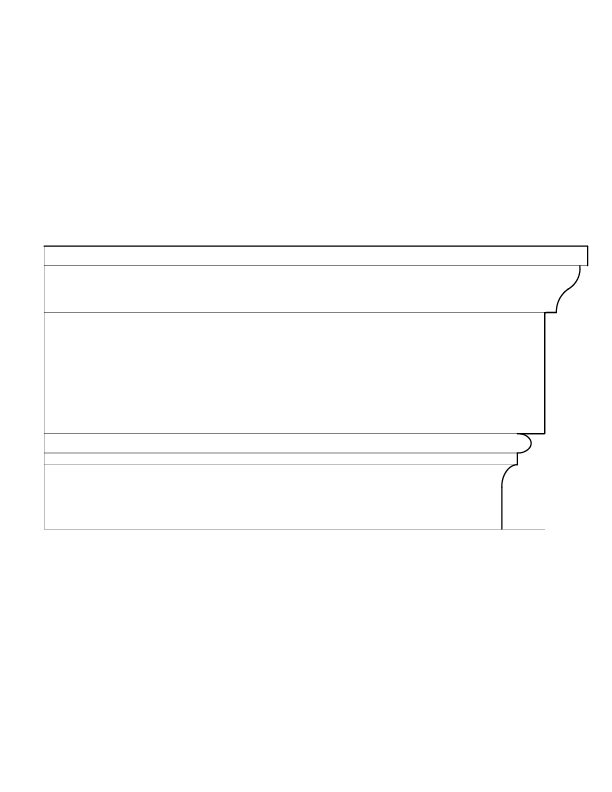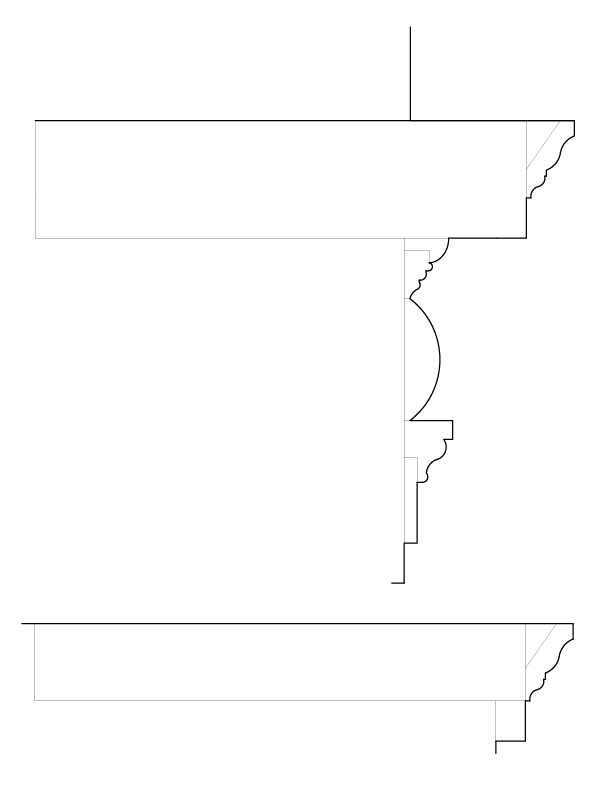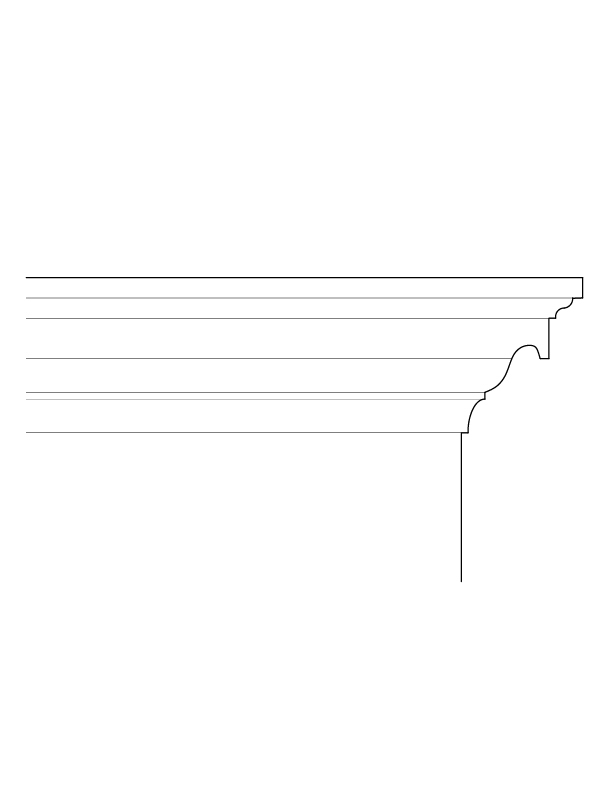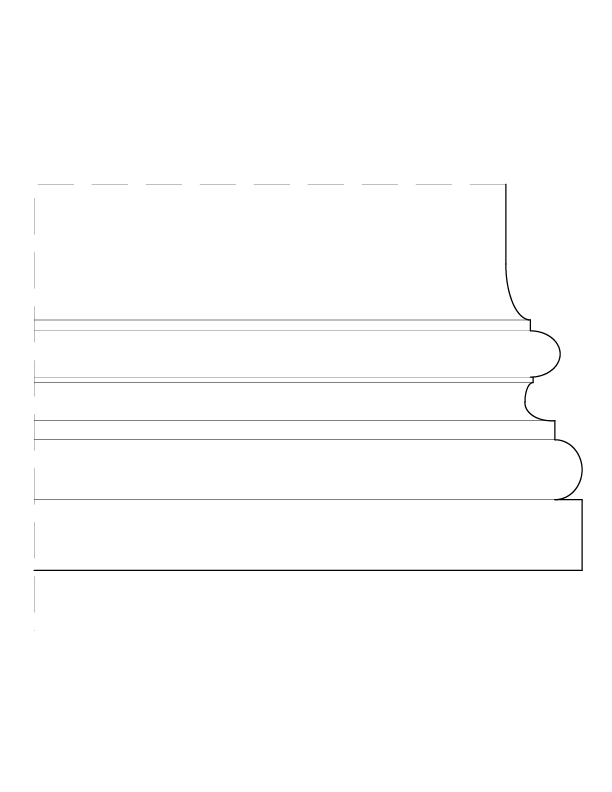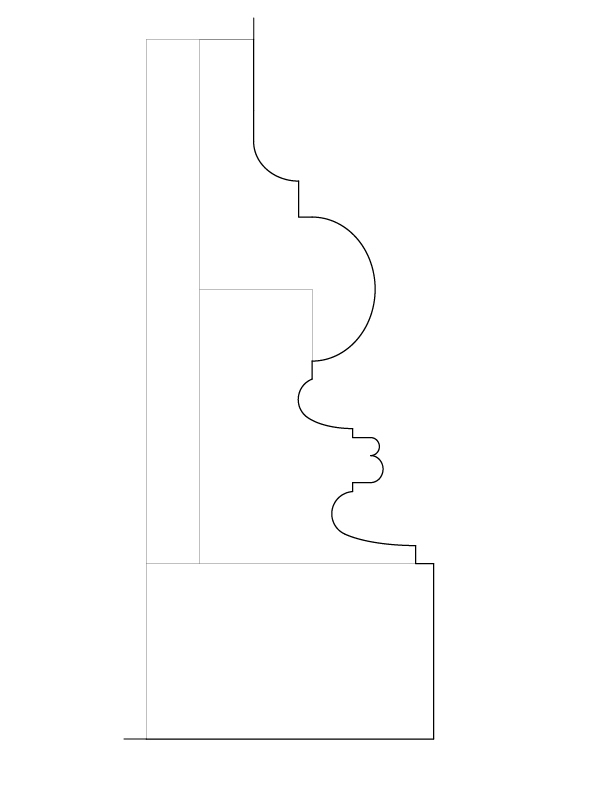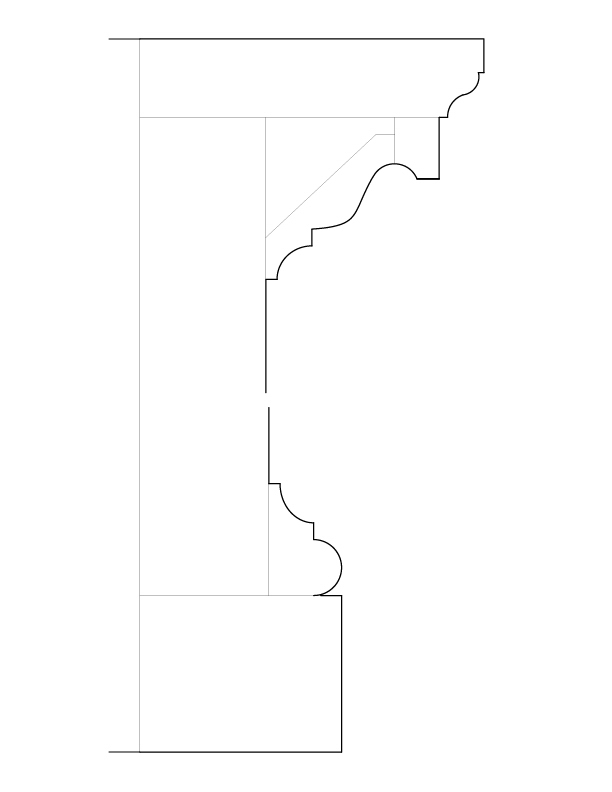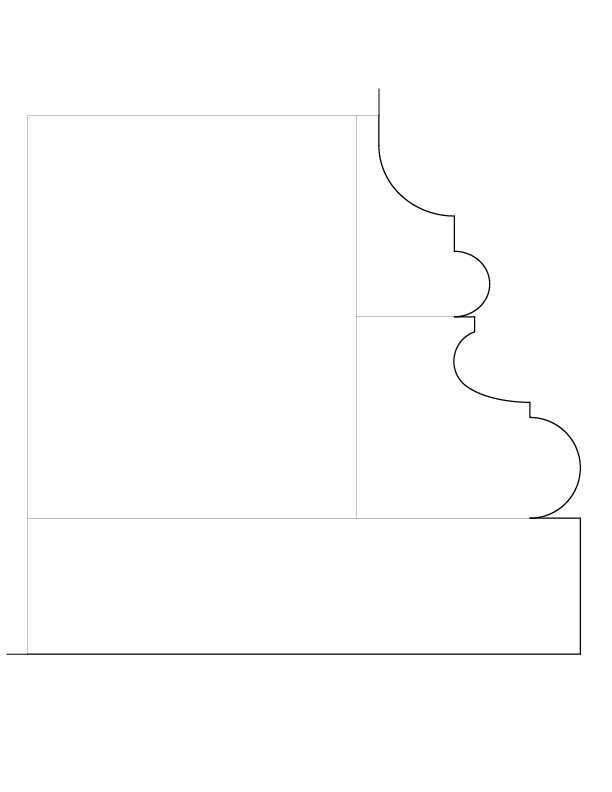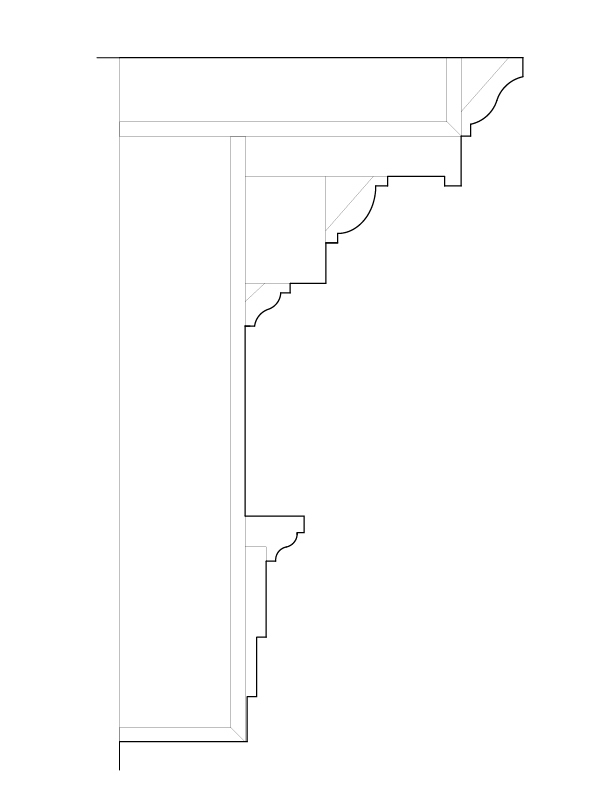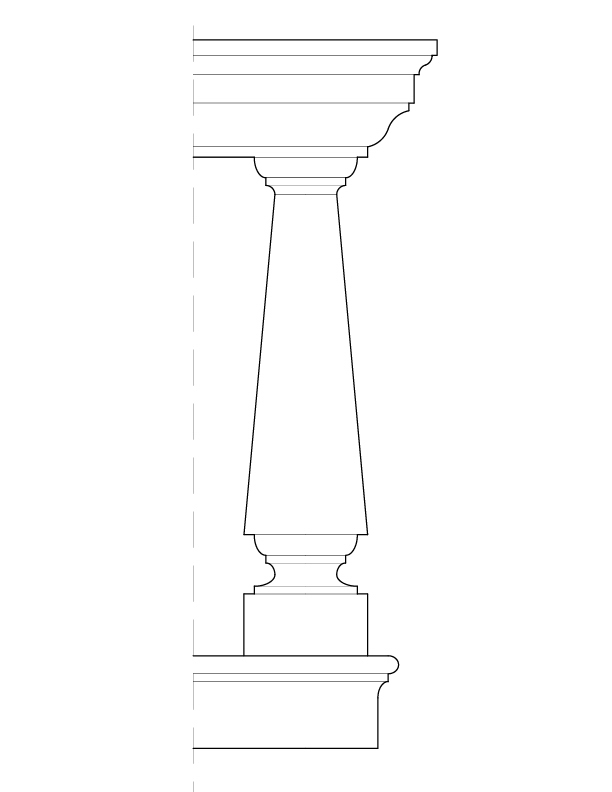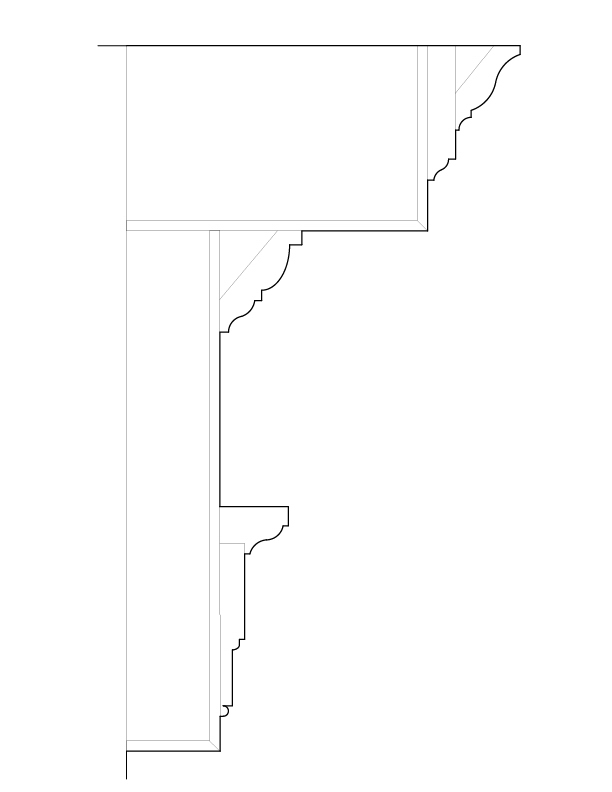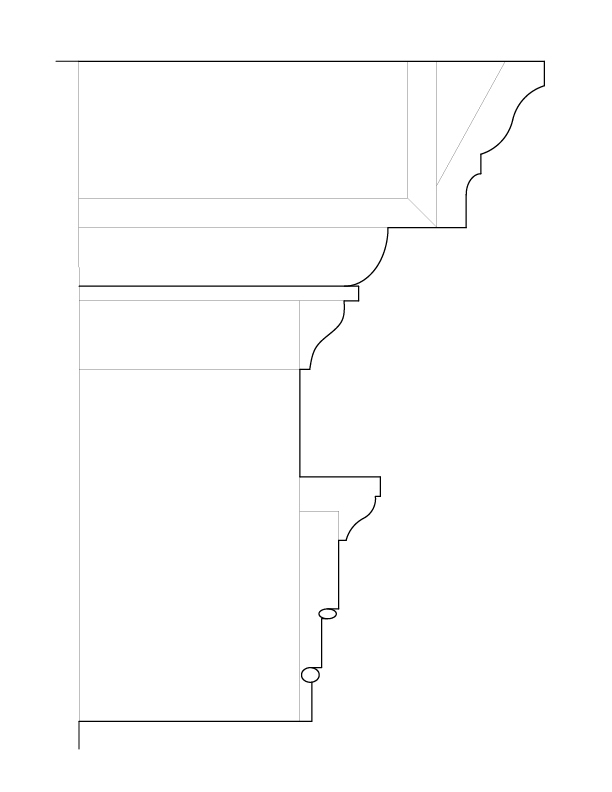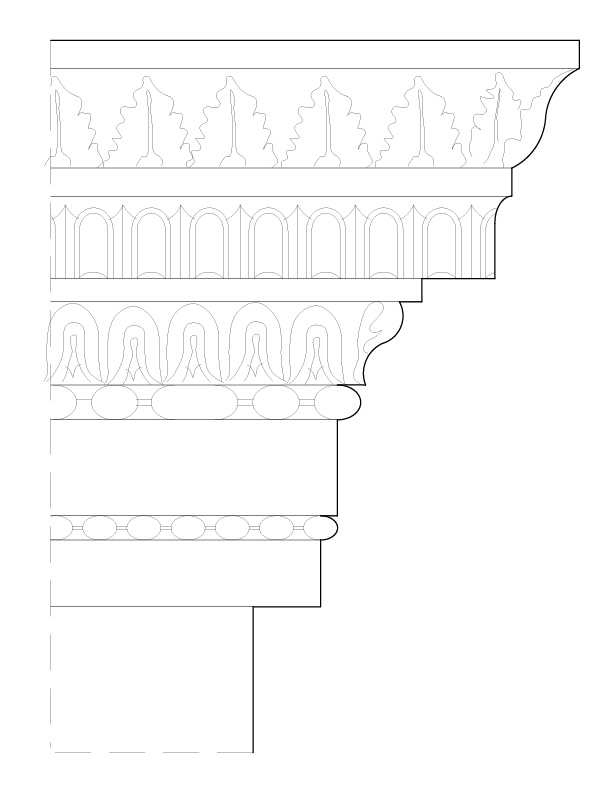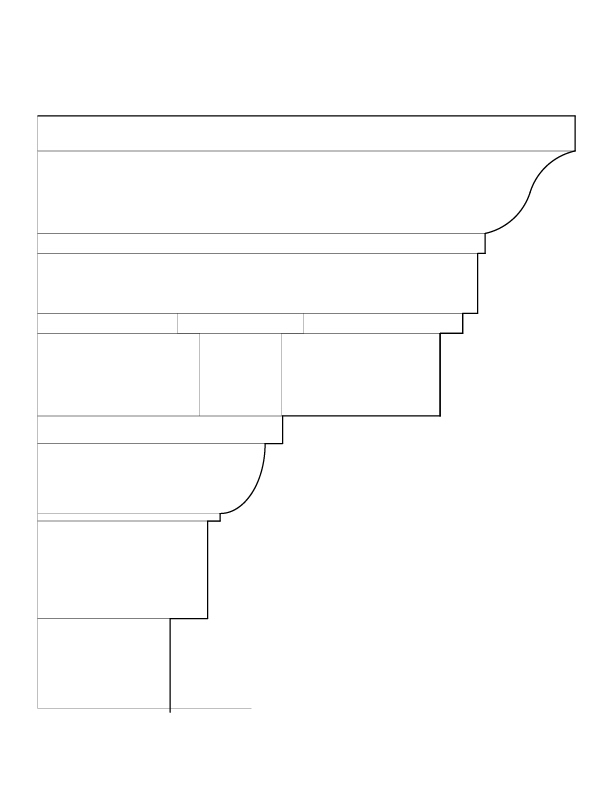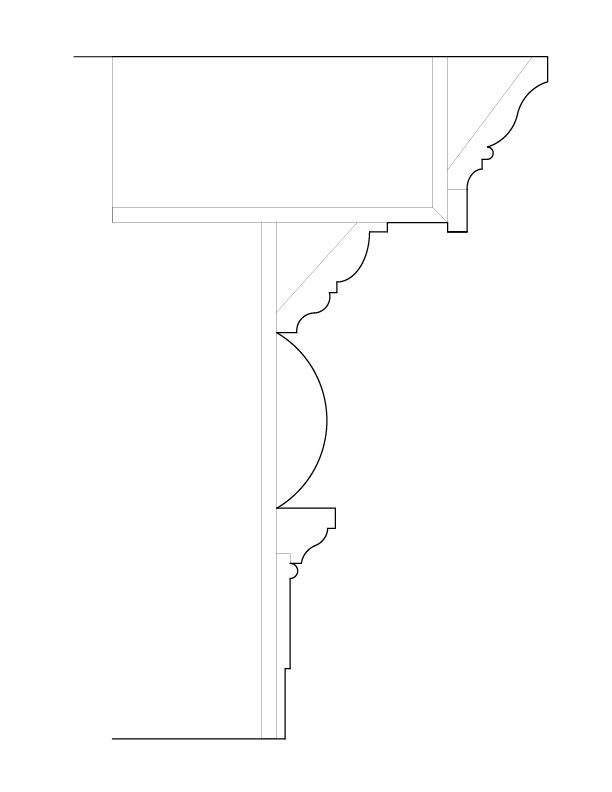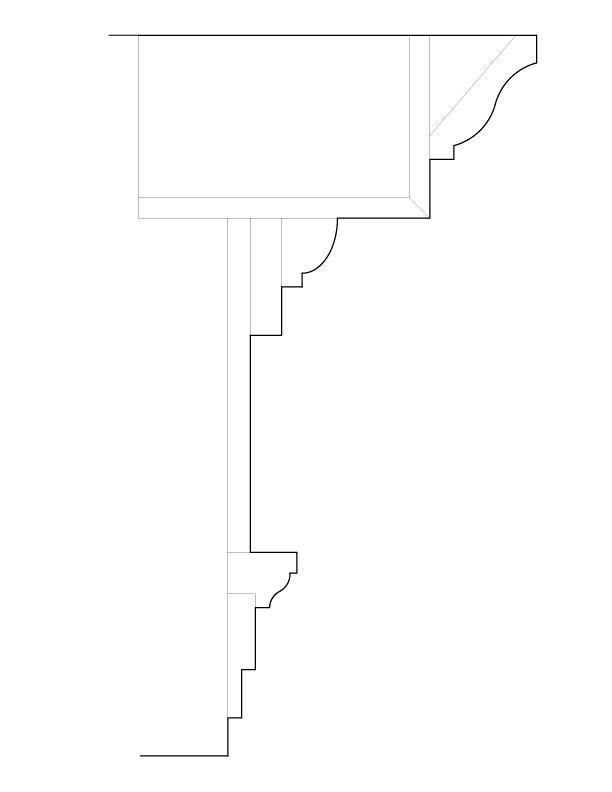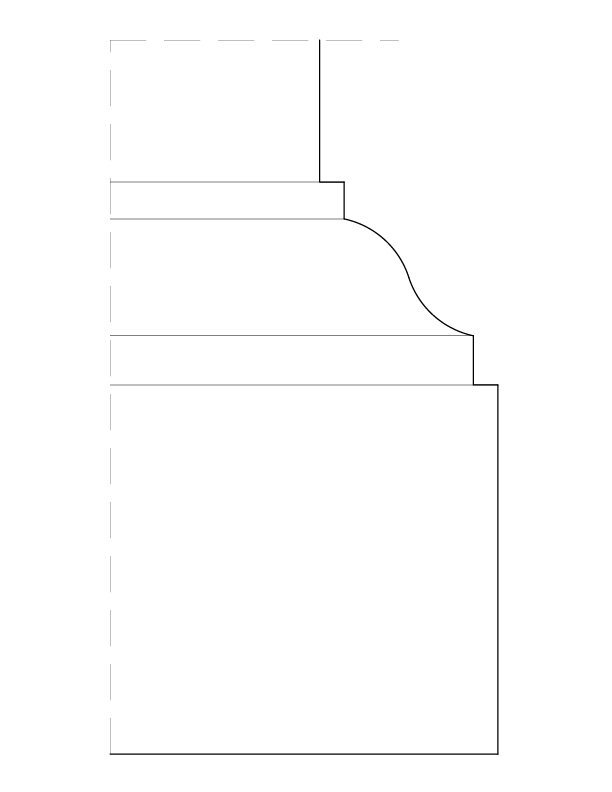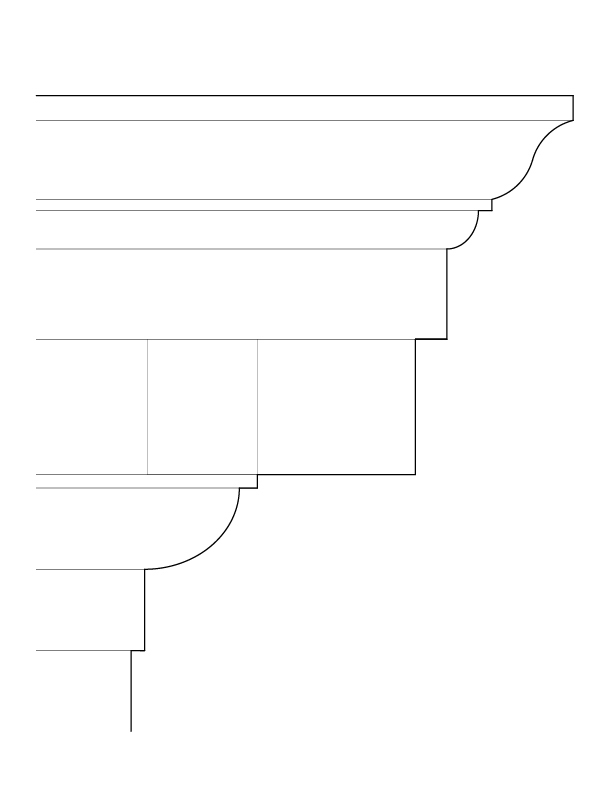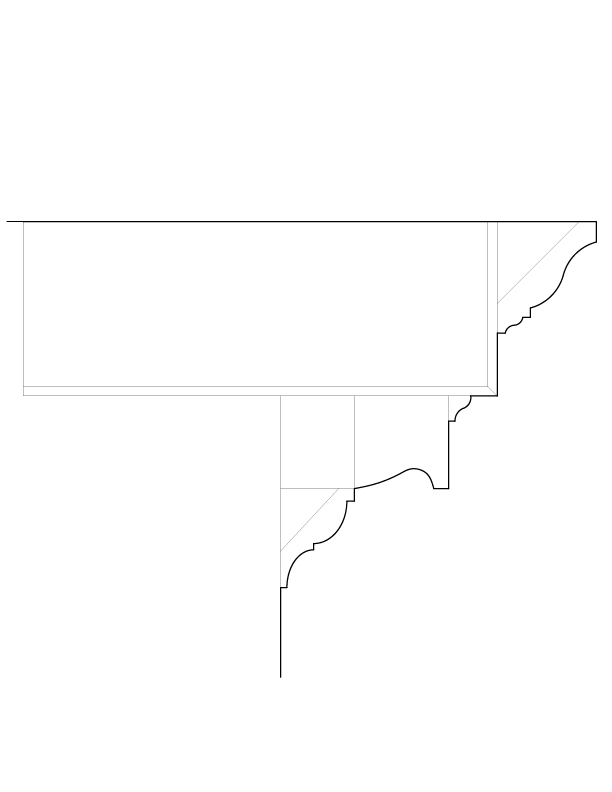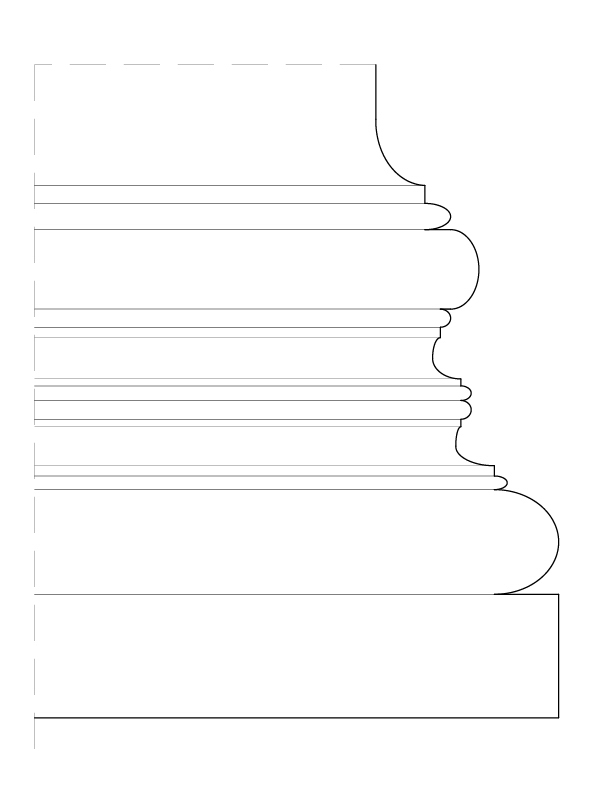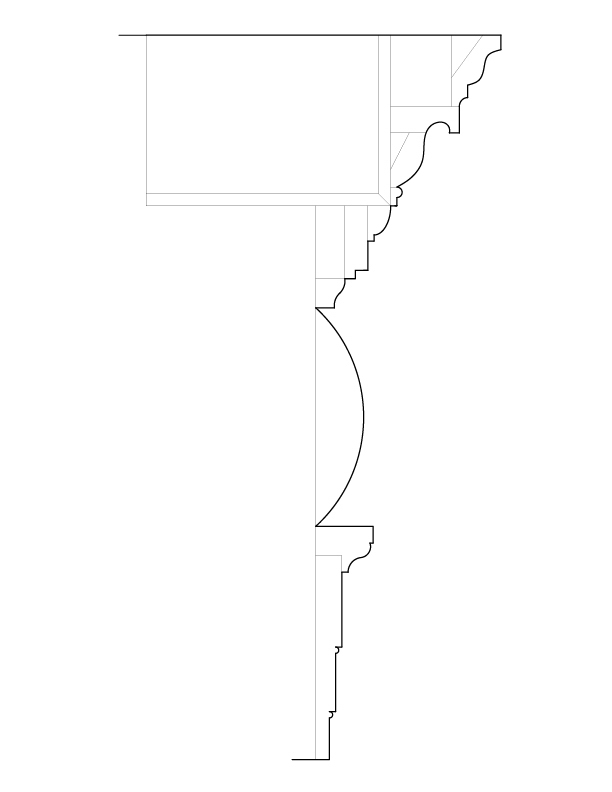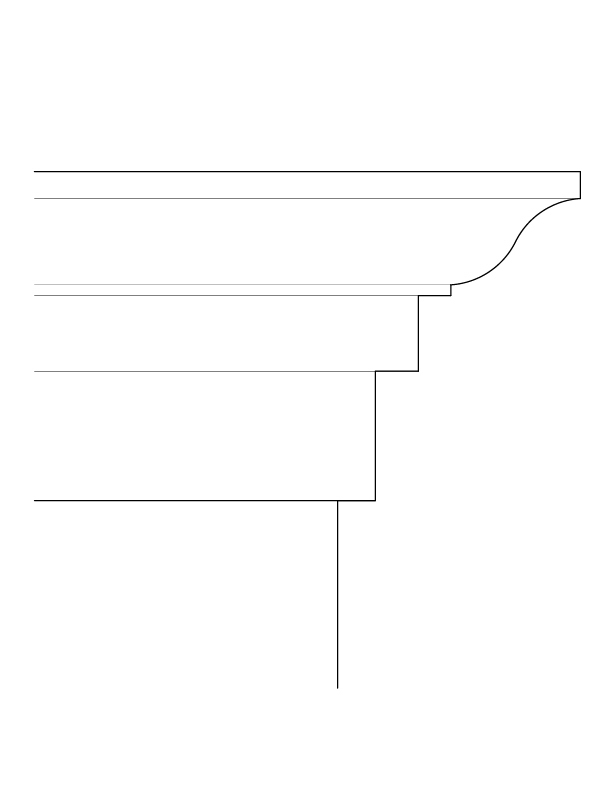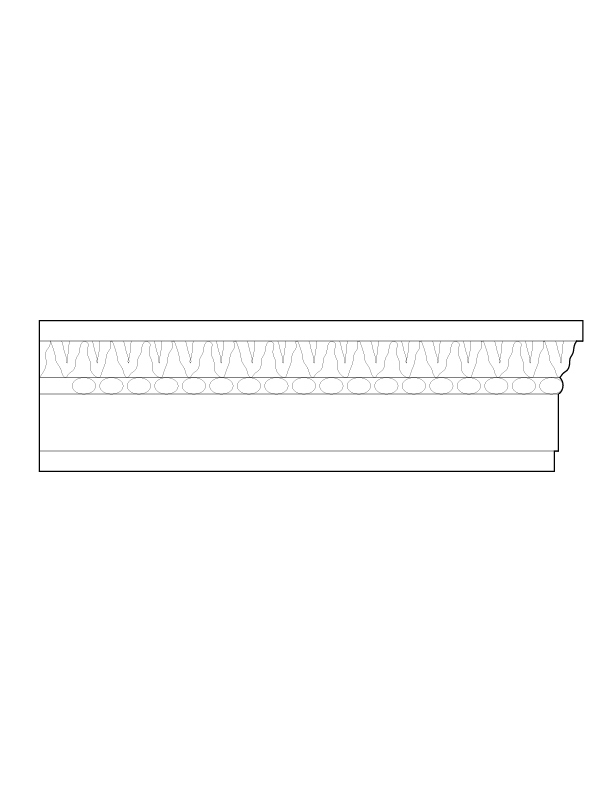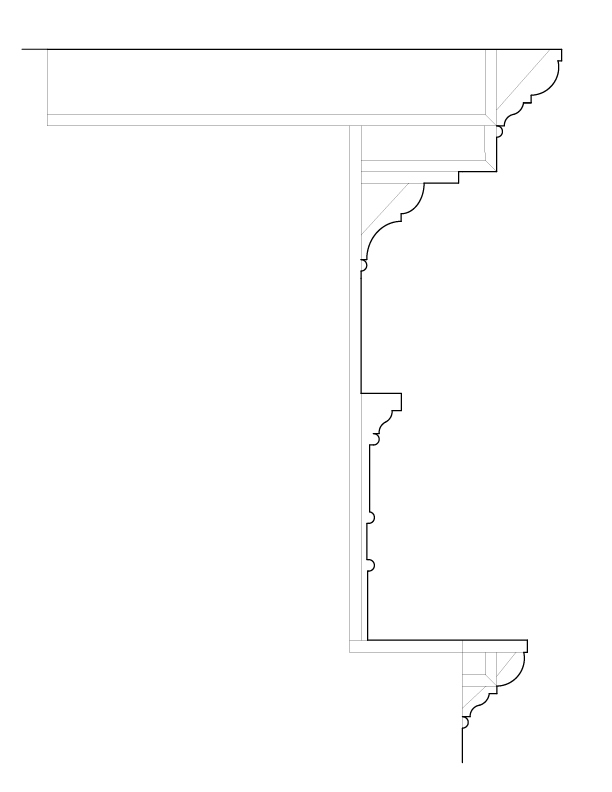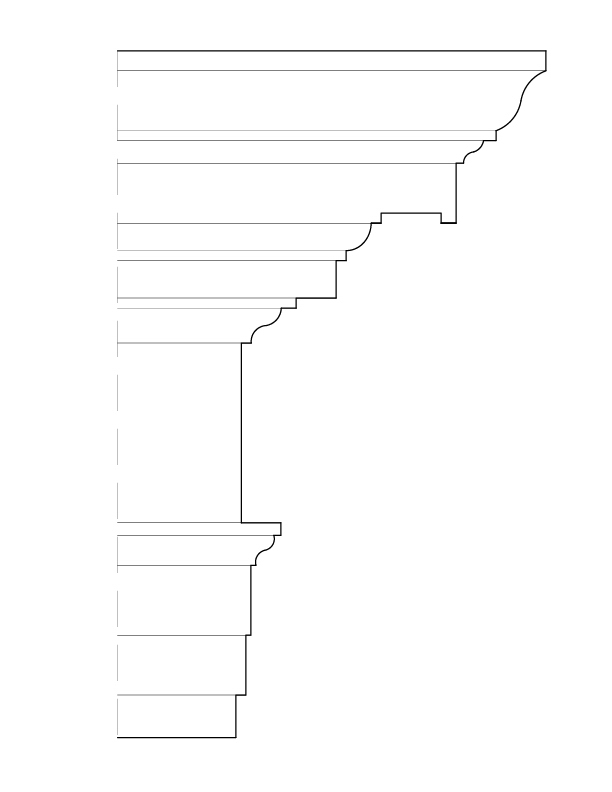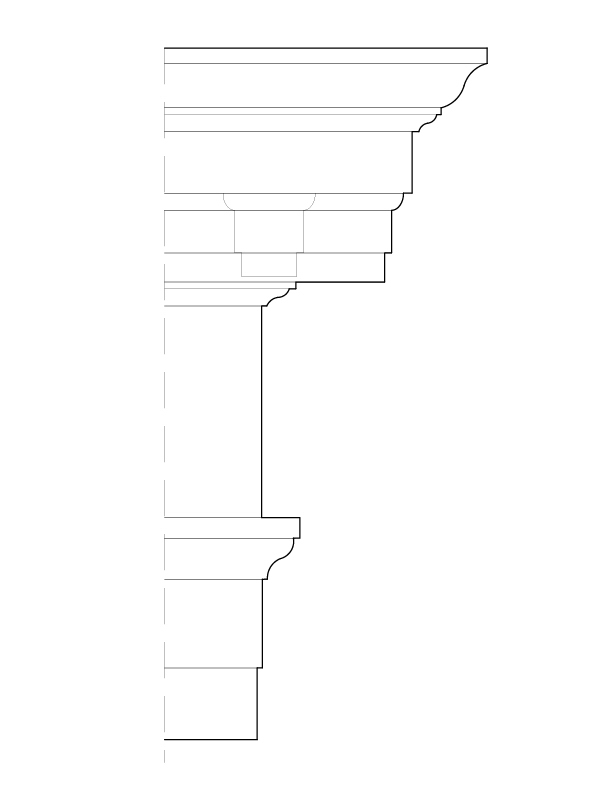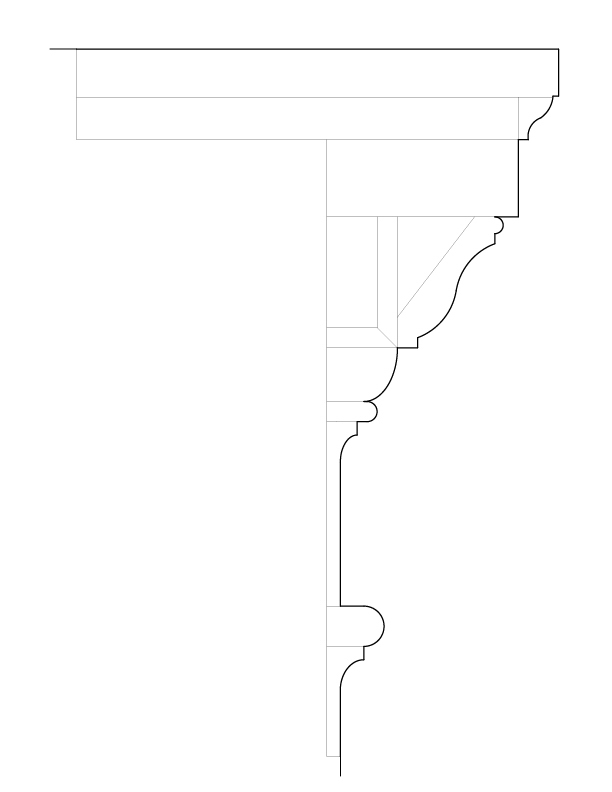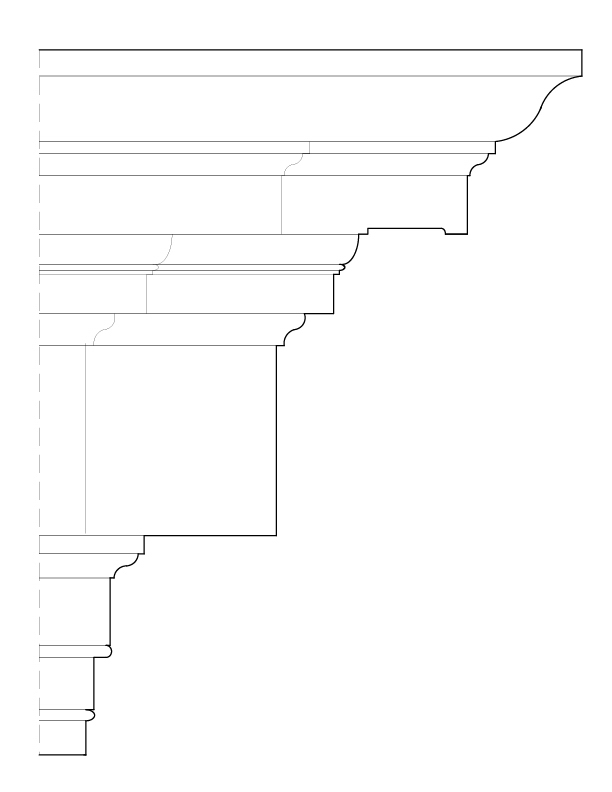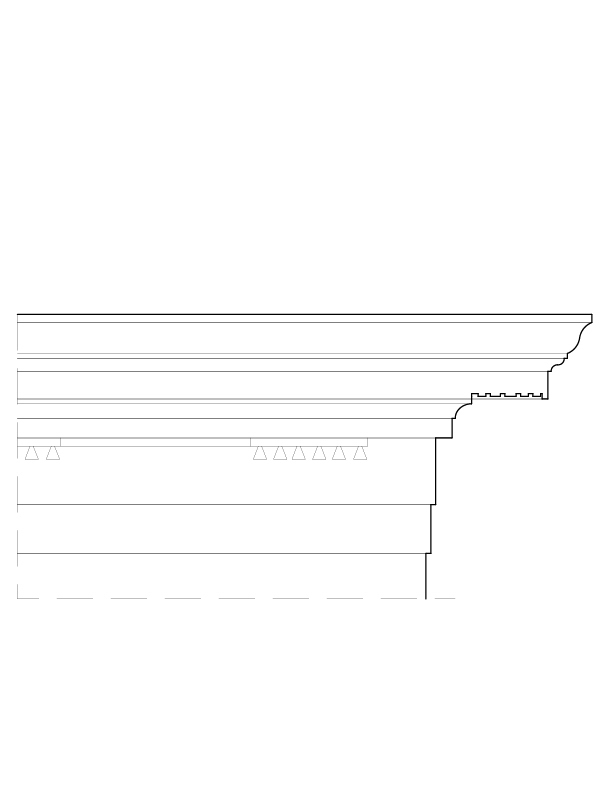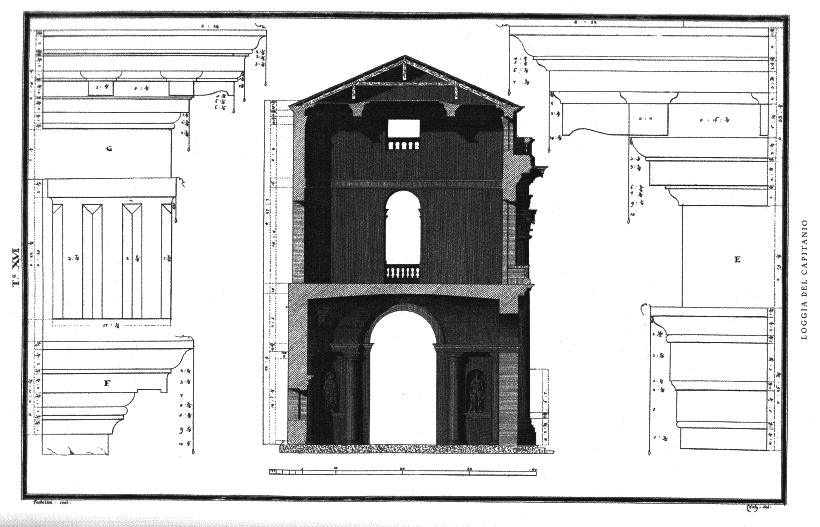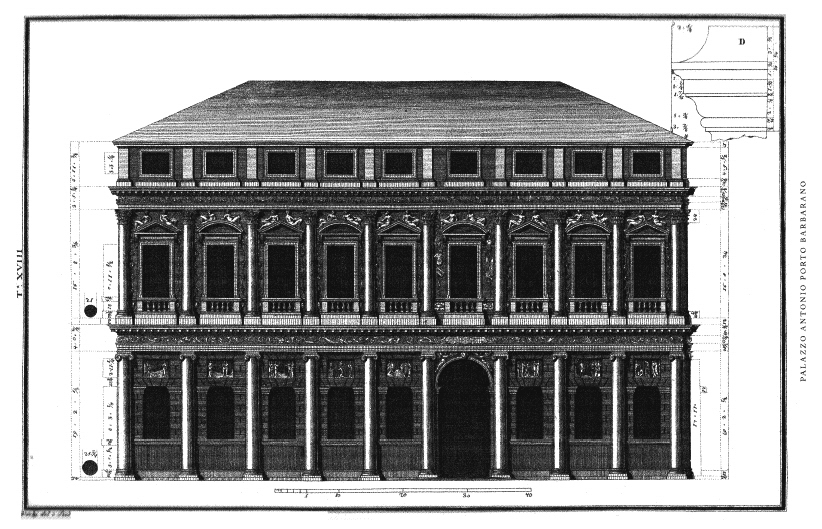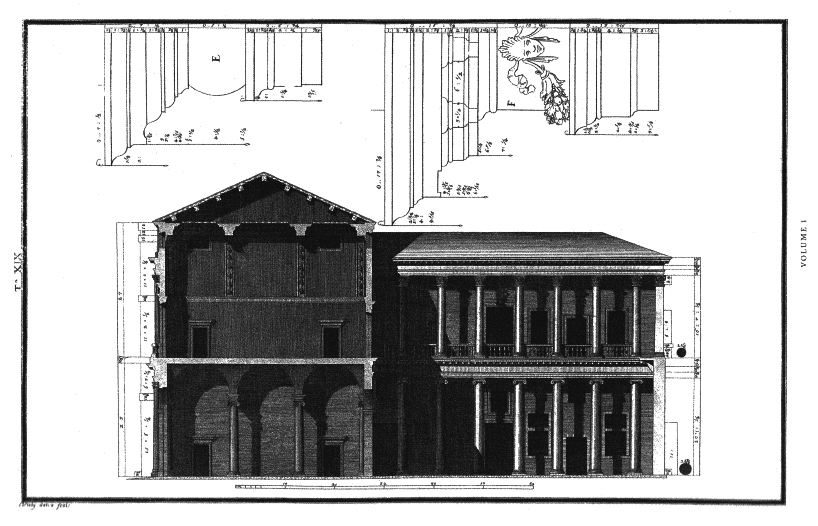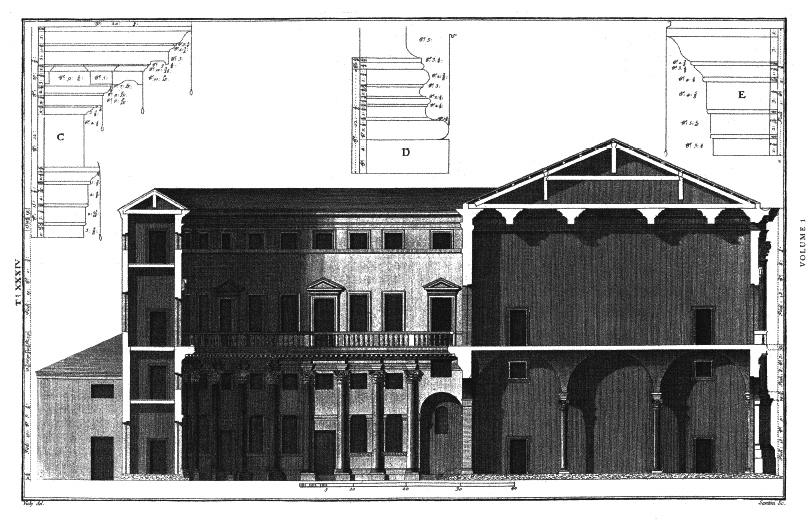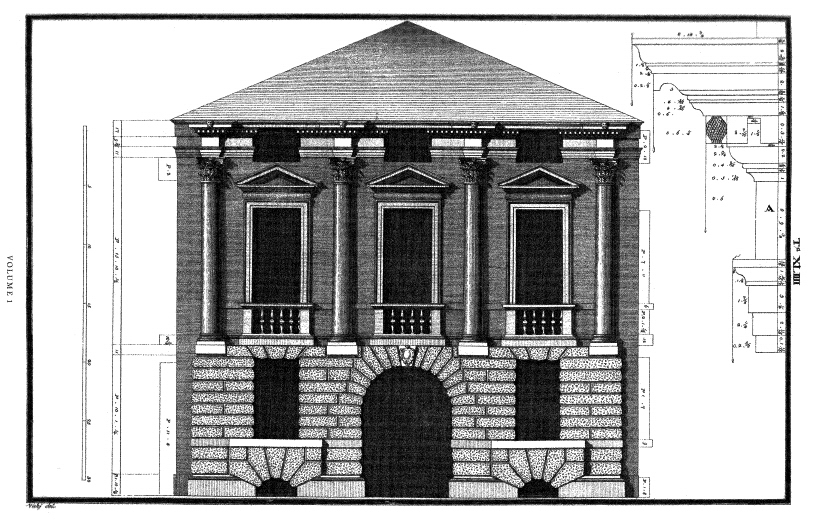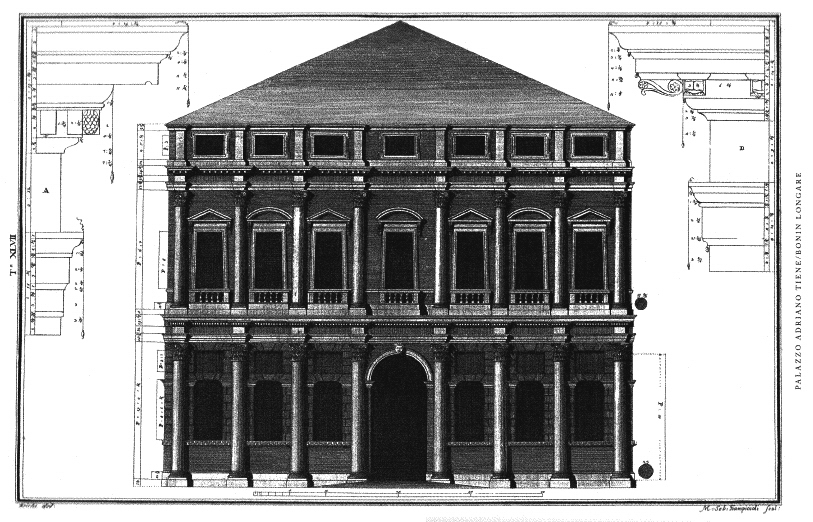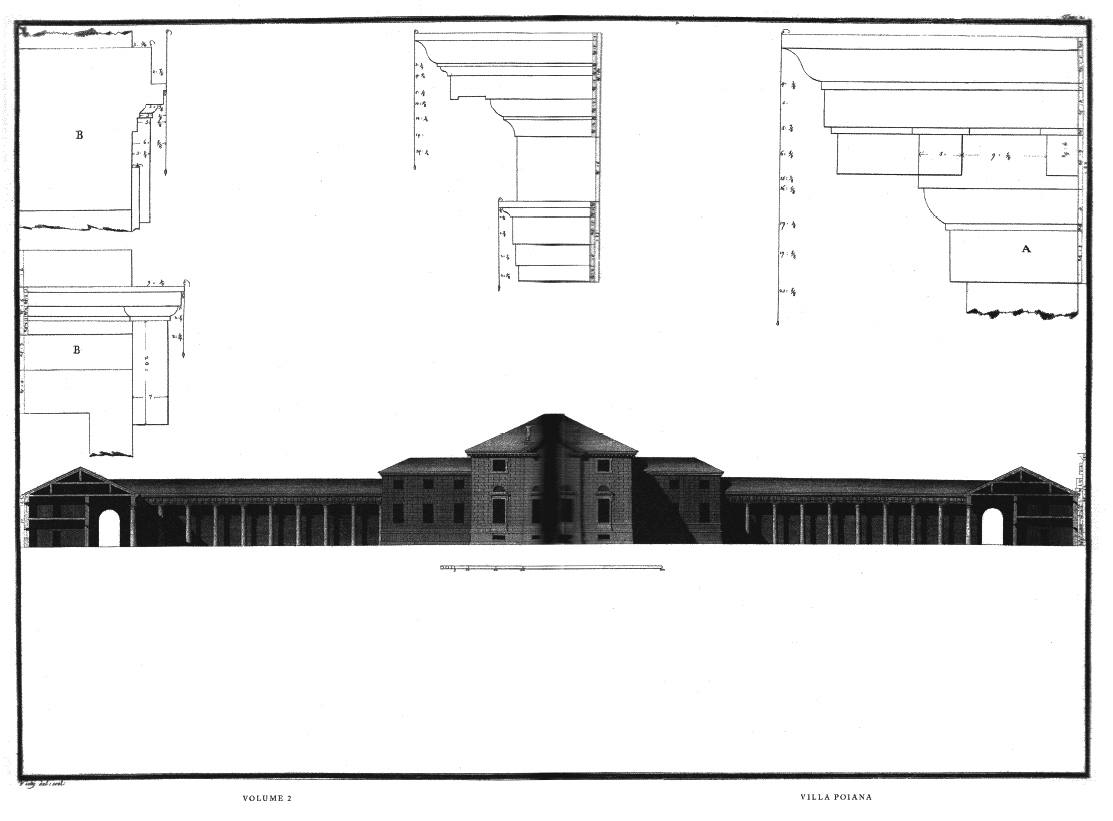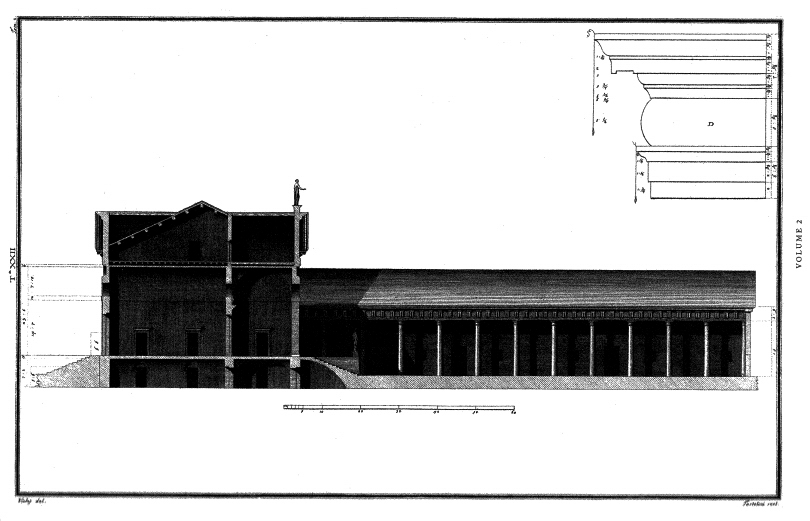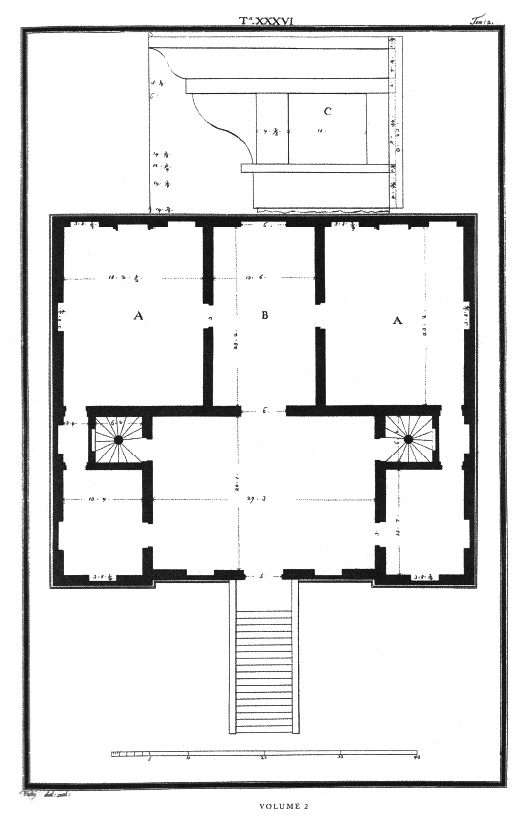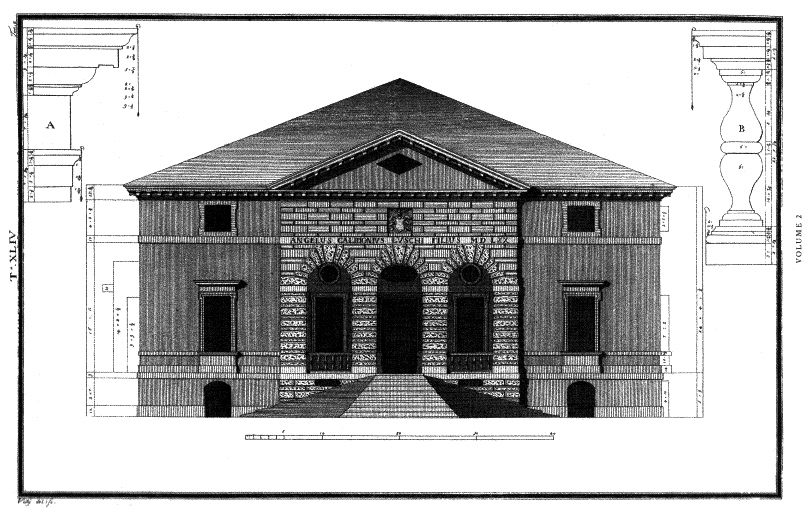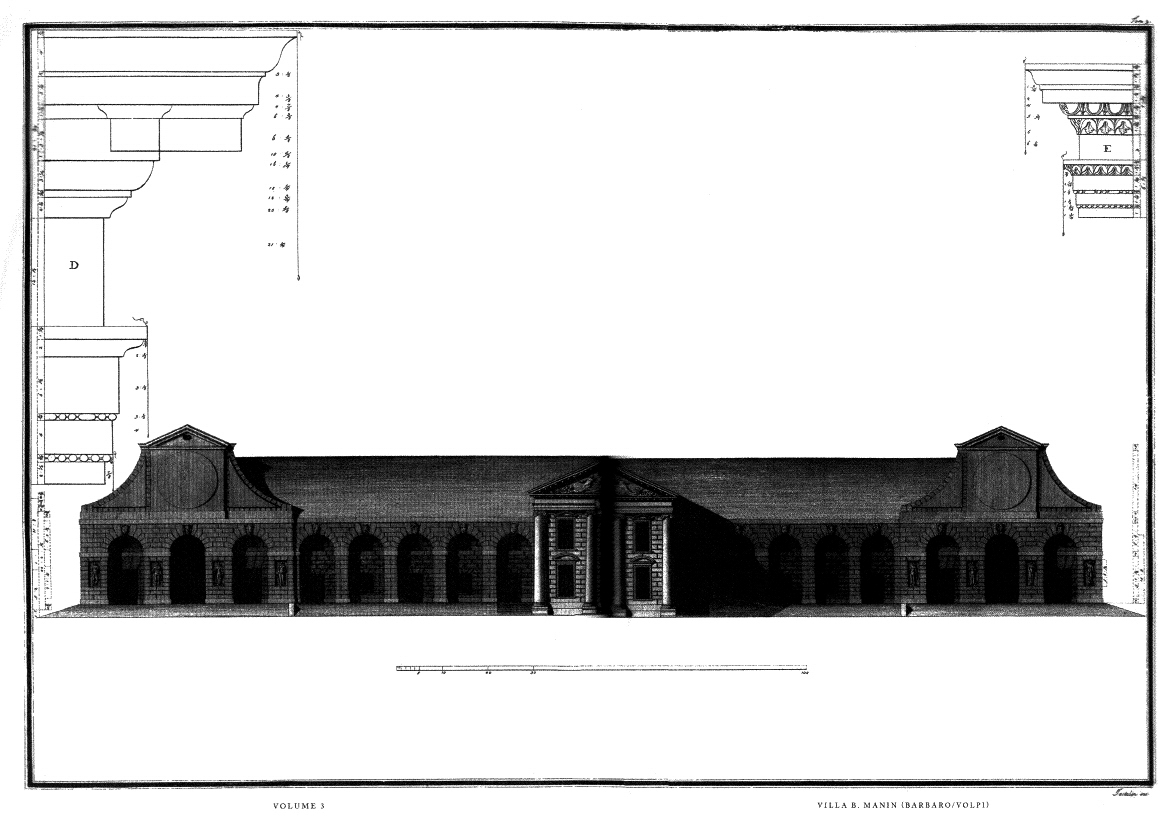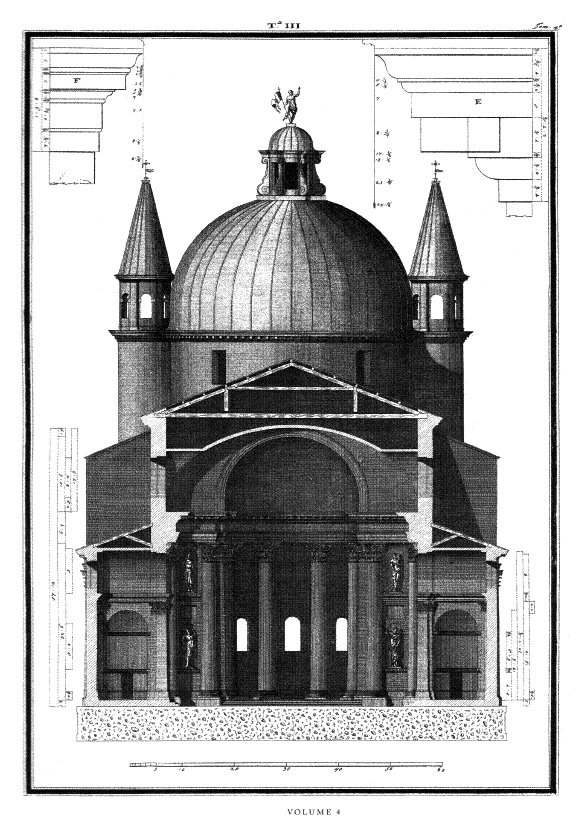Born Andrea di Pietro della Gondola in 1508, Andrea Palladio is regarded as the greatest architect of 16th-century Italy and one of the most influential figures in Western architecture.
While working as a stone mason, he was found by Gian Giorgio Trissino, the humanist poet and scholar, who was building a villa meant to house a learned academy based on the work of the Roman architect, Vitruvius. Tressino undertook Andrea’s humanist education and renamed him “Palladio” alluding to great wisdom and useful arts, ultimately inspiring him to write Il Quatro Libri del Architectura, Palladio’s Four Books of Architecture.
He measured and drew the ancient ruins in Rome, was inspired by Sansovino and Serlio, and designed and built what many consider the most perfect modern expressions of the classical architectural language. His judicious use of molded profiles was carefully considered, enhancing the overall aesthetic of a building without overpowering and detracting from its beauty, strength, and functionality.
PALAZZO CHIERICATI, VICENZA
PALAZZO CHIERICATI, VICENZA
PALAZZO CHIERICATI, VICENZA
PALAZZO CHIERICATI, VICENZA
LOGGIA DEL CAPITANIATO, VICENZA
LOGGIA DEL CAPITANIATO, VICENZA
LOGGIA DEL CAPITANIATO, VICENZA
LOGGIA DEL CAPITANIATO, VICENZA
LOGGIA DEL CAPITANIATO, VICENZA
LOGGIA DEL CAPITANIATO, VICENZA
LOGGIA DEL CAPITANIATO, VICENZA
LOGGIA DEL CAPITANIATO, VICENZA
LOGGIA DEL CAPITANIATO, VICENZA
LOGGIA DEL CAPITANIATO, VICENZA
LOGGIA DEL CAPITANIATO, VICENZA
LOGGIA DEL CAPITANIATO, VICENZA
LOGGIA DEL CAPITANIATO, VICENZA
PALAZZO BARBARAN DA PORTO, VICENZA
PALAZZO BARBARAN DA PORTO, VICENZA
PALAZZO VALMARANA, VICENZA
PALAZZO VALMARANA, VICENZA
PALAZZO VALMARANA, VICENZA
PALAZZO VALMARANA, VICENZA
PALAZZO VALMARANA, VICENZA
PALAZZO VALMARANA, VICENZA
PALAZZO VALMARANA, VICENZA
PALAZZO VALMARANA, VICENZA
PALAZZO VALMARANA, VICENZA
PALAZZO VALMARANA, VICENZA
PALAZZO VALMARANA, VICENZA
PALAZZO VALMARANA, VICENZA
PALAZZO PORTO IN PIAZZA CASTELLO, VICENZA
PALAZZO PORTO IN PIAZZA CASTELLO, VICENZA
PALAZZO PORTO IN PIAZZA CASTELLO, VICENZA
PALAZZO PORTO IN PIAZZA CASTELLO, VICENZA
PALAZZO PORTO IN PIAZZA CASTELLO, VICENZA
PALAZZO PORTO IN PIAZZA CASTELLO, VICENZA
PALAZZO PORTO IN PIAZZA CASTELLO, VICENZA
PALAZZO PORTO IN PIAZZA CASTELLO, VICENZA
PALAZZO PORTO IN PIAZZA CASTELLO, VICENZA
PALAZZO PORTO IN PIAZZA CASTELLO, VICENZA
PALAZZO PORTO IN PIAZZA CASTELLO, VICENZA
PALAZZO PORTO IN PIAZZA CASTELLO, VICENZA
PALAZZO PORTO IN PIAZZA CASTELLO, VICENZA
PALAZZO PORTO IN PIAZZA CASTELLO, VICENZA
LOGGIA VALMARANA, VICENZA
LOGGIA VALMARANA, VICENZA
LOGGIA VALMARANA, VICENZA
LOGGIA VALMARANA, VICENZA
LOGGIA VALMARANA, VICENZA
LOGGIA VALMARANA, VICENZA
PALAZZO THIENE BONIN LONGARE, VICENZA
PALAZZO THIENE BONIN LONGARE, VICENZA
PALAZZO THIENE BONIN LONGARE, VICENZA
PALAZZO THIENE BONIN LONGARE, VICENZA
PALAZZO THIENE BONIN LONGARE, VICENZA
PALAZZO THIENE BONIN LONGARE, VICENZA
PALAZZO THIENE BONIN LONGARE, VICENZA
PALAZZO THIENE BONIN LONGARE, VICENZA
PALAZZO THIENE BONIN LONGARE, VICENZA
PALAZZO THIENE BONIN LONGARE, VICENZA
PALAZZO THIENE BONIN LONGARE, VICENZA
PALAZZO THIENE BONIN LONGARE, VICENZA
PALAZZO THIENE BONIN LONGARE, VICENZA
PALAZZO THIENE BONIN LONGARE, VICENZA
PALAZZO THIENE BONIN LONGARE, VICENZA
PALAZZO THIENE BONIN LONGARE, VICENZA
VILLA LA ROTONDA, VICENZA
VILLA LA ROTONDA, VICENZA
VILLA LA ROTONDA, VICENZA
VILLA LA ROTONDA, VICENZA
VILLA LA ROTONDA, VICENZA
VILLA LA ROTONDA, VICENZA
VILLA LA ROTONDA, VICENZA
VILLA LA ROTONDA, VICENZA
VILLA LA ROTONDA, VICENZA
VILLA LA ROTONDA, VICENZA
VILLA LA ROTONDA, VICENZA
VILLA LA ROTONDA, VICENZA
VILLA LA ROTONDA, VICENZA
VILLA LA ROTONDA, VICENZA
VILLA LA ROTONDA, VICENZA
VILLA LA ROTONDA, VICENZA
VILLA PISANI-PLACCO, MONTAGNANA
VILLA PISANI-PLACCO, MONTAGNANA
VILLA PISANI-PLACCO, MONTAGNANA
VILLA PISANI-PLACCO, MONTAGNANA
VILLA PISANI-PLACCO, MONTAGNANA
VILLA PISANI-PLACCO, MONTAGNANA
VILLA PISANI-PLACCO, MONTAGNANA
VILLA PISANI-PLACCO, MONTAGNANA
VILLA PISANI-PLACCO, MONTAGNANA
VILLA PISANI-PLACCO, MONTAGNANA
VILLA PISANI-PLACCO, MONTAGNANA
VILLA PISANI-PLACCO, MONTAGNANA
VILLA DA SCHIO CARETTA, LEVA
VILLA DA SCHIO CARETTA, LEVA
VILLA DA SCHIO CARETTA, LEVA
VILLA DA SCHIO CARETTA, LEVA
VILLA PIETRO CALDOGNO, FINALE
VILLA PIETRO CALDOGNO, FINALE
VILLA PIETRO CALDOGNO, FINALE
VILLA PIETRO CALDOGNO, FINALE
VILLA PIETRO CALDOGNO, FINALE
VILLA PIETRO CALDOGNO, FINALE
VILLA PIETRO CALDOGNO, FINALE
VILLA PIETRO CALDOGNO, FINALE
VILLA PIETRO CALDOGNO, FINALE
VILLA PIETRO CALDOGNO, FINALE
VILLA PIETRO CALDOGNO, FINALE
VILLA PIETRO CALDOGNO, FINALE
VILLA ANGELO MARCELLO, BERTESINA
VILLA ANGELO MARCELLO, BERTESINA
VILLA ANGELO MARCELLO, BERTESINA
VILLA ANGELO MARCELLO, BERTESINA
VILLA ANGELO MARCELLO, BERTESINA
VILLA ANGELO MARCELLO, BERTESINA
VILLA ANGELO MARCELLO, BERTESINA
VILLA ANGELO MARCELLO, BERTESINA
VILLA ANGELO MARCELLO, BERTESINA
VILLA ANGELO MARCELLO, BERTESINA
VILLA GIACOMO FOSCARINI, STRA FOSCARINI
VILLA GIACOMO FOSCARINI, STRA FOSCARINI
VILLA GIACOMO FOSCARINI, STRA FOSCARINI
VILLA GIACOMO FOSCARINI, STRA FOSCARINI
THE CHIESA DEL SANTISSIMO REDENTORE, VENICE
THE CHIESA DEL SANTISSIMO REDENTORE, VENICE
THE CHIESA DEL SANTISSIMO REDENTORE, VENICE
THE CHIESA DEL SANTISSIMO REDENTORE, VENICE
THE CHIESA DEL SANTISSIMO REDENTORE, VENICE
THE CHIESA DEL SANTISSIMO REDENTORE, VENICE
THE CHIESA DEL SANTISSIMO REDENTORE, VENICE
THE CHIESA DEL SANTISSIMO REDENTORE, VENICE
THE CHIESA DEL SANTISSIMO REDENTORE, VENICE
THE CHIESA DEL SANTISSIMO REDENTORE, VENICE
THE CHIESA DEL SANTISSIMO REDENTORE, VENICE
THE CHIESA DEL SANTISSIMO REDENTORE, VENICE
THE CHIESA DEL SANTISSIMO REDENTORE, VENICE
THE CHIESA DEL SANTISSIMO REDENTORE, VENICE
THE CHIESA DEL SANTISSIMO REDENTORE, VENICE
THE CHIESA DEL SANTISSIMO REDENTORE, VENICE
THE CHIESA DEL SANTISSIMO REDENTORE, VENICE
THE CHIESA DEL SANTISSIMO REDENTORE, VENICE
THE CHIESA DEL SANTISSIMO REDENTORE, VENICE
THE CHIESA DEL SANTISSIMO REDENTORE, VENICE
THE CHIESA DEL SANTISSIMO REDENTORE, VENICE
THE CHIESA DEL SANTISSIMO REDENTORE, VENICE
THE CHIESA DEL SANTISSIMO REDENTORE, VENICE
THE CHIESA DEL SANTISSIMO REDENTORE, VENICE
TEMPIETTO B. MANIN, MASER
TEMPIETTO B. MANIN, MASER
TEMPIETTO B. MANIN, MASER
TEMPIETTO B. MANIN, MASER
TEMPIETTO B. MANIN, MASER
TEMPIETTO B. MANIN, MASER
CHIESA DI SANTA MARIA DELLA PRESENTAZIONE, VENICE
CHIESA DI SANTA MARIA DELLA PRESENTAZIONE, VENICE
CHIESA DI SANTA MARIA DELLA PRESENTAZIONE, VENICE
CHIESA DI SANTA MARIA DELLA PRESENTAZIONE, VENICE
CHIESA DI SANTA MARIA DELLA PRESENTAZIONE, VENICE
CHIESA DI SANTA MARIA DELLA PRESENTAZIONE, VENICE
CHIESA DI SANTA MARIA DELLA PRESENTAZIONE, VENICE
CHIESA DI SANTA MARIA DELLA PRESENTAZIONE, VENICE
CHIESA DI SANTA MARIA DELLA PRESENTAZIONE, VENICE
CHIESA DI SANTA MARIA DELLA PRESENTAZIONE, VENICE
CHIESA DI SANTA MARIA DELLA PRESENTAZIONE, VENICE
CHIESA DI SANTA MARIA DELLA PRESENTAZIONE, VENICE
SAN FRANCESCO DELLA VIGNA, VENICE
SAN FRANCESCO DELLA VIGNA, VENICE
SAN FRANCESCO DELLA VIGNA, VENICE
SAN FRANCESCO DELLA VIGNA, VENICE
PALAZZO DELLA TORRE, VERONA
PALAZZO DELLA TORRE, VERONA
PALAZZO DELLA TORRE, VERONA
PALAZZO DELLA TORRE, VERONA
